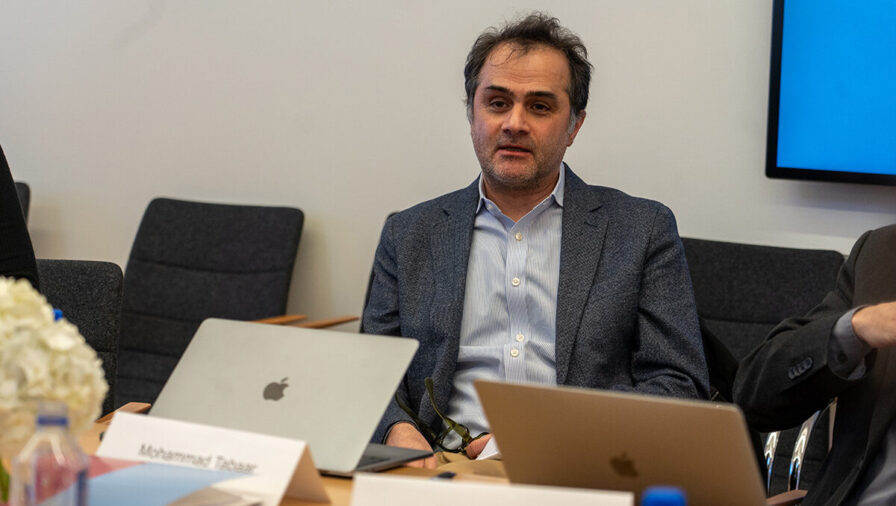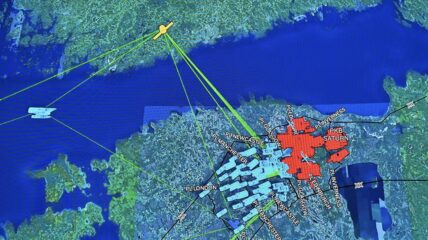This article is published as part of the Perry World House workshop “U.S.-Iran Relations Under Trump 2.0: Lessons Learned and Likely Scenarios.”
The October 7, 2023, Hamas attacks on Israel and the ensuing war in Gaza have reshaped the Middle East’s strategic landscape. While many in Washington view these developments as a blow to Iran—exposing its military vulnerabilities and weakening its regional allies—Iranian leaders have a different perception. For Supreme Leader Ali Khamenei and the Islamic Revolutionary Guard Corps (IRGC), the current moment is not one of retreat, but recalibration. Rather than a collapse of influence, they see temporary setbacks in a generational struggle. Far from standing still, Tehran is adjusting its regional posture, elevating new partners, exploring quiet diplomacy with former rivals, and preparing for potential direct confrontation with the United States.
Setbacks, Not Defeats
From the perspective of many U.S. analysts, Iran’s position appears weakened. The war in Gaza has inflicted heavy losses on Hamas alongside the deaths of tens of thousands of Palestinian civilians. In Lebanon, Hezbollah has lost key commanders, including its leader Hassan Nasrallah to Israeli strikes. Moreover, the organization’s influence in Lebanese politics has diminished with the rise of a new president and prime minister who are less deferential to Hezbollah. Iran itself has faced direct military blows, including the assassination of senior IRGC commanders in Syria and Israeli attacks on its air defense systems and missile production infrastructure. These developments—echoed by some analysts within Iran—seem to point to a vulnerable Tehran.
Yet Iran’s leadership interprets the moment differently. In their view, Hamas’s survival under siege and its continued hold over Gaza constitute a symbolic and strategic victory. Ayatollah Ali Khamenei has framed Gaza’s endurance as a powerful act of resistance against not only Israel but also its U.S. backers. In a February 2025 meeting with Hamas leaders, Khamenei declared: “You overcame the Zionist regime—and in fact, the United States—and by God’s grace, you did not allow them to achieve any of their objectives.” The narrative in Tehran emphasizes not defeat, but resistance and martyrdom—a framing that continues to resonate deeply across segments of the Arab and Muslim world. In the same meeting, Khamenei stated: “The result of all these hardships and sacrifices was ultimately the triumph of right over wrong, and the people of Gaza became a model for all those who are devoted to the cause of resistance.”
Similarly, while Hezbollah has come under pressure, it is still seen by Iranian leaders as a formidable actor with deep roots in Lebanon’s political system and society. In his March 20 Nowruz (Persian New Year) address, Khamenei acknowledged recent tragedies while invoking Quranic parables to emphasize perseverance and ultimate triumph—equating the struggle of today’s resistance with the biblical endurance of Moses and his followers.
“In the events of the past year, we lost great figures—esteemed personalities from both Iran and Lebanon. These were real tragedies for us, much like the story of Moses. He too did not have a life of peace and comfort when he came to Egypt. He and the Israelites were under immense hardship. The Israelites were telling Moses that they had been suffering under torture even before he arrived as a prophet to stand up to Pharaoh—and that they were still suffering after his arrival. Moses replied to his people. He told them to ask for divine assistance, to be patient and steadfast—things would eventually be resolved. And they were. The very same people who had been complaining about their suffering saw with their own eyes how Pharaoh and his followers were utterly humiliated and drowned in the sea. They were destroyed, and no trace of their power or kingdom remained.”
The Islamic Republic remains confident that, over time, the destruction in Gaza will fuel mass anger and radicalization, which in turn will replenish and even expand the ranks of the “Axis of Resistance” — Tehran’s transnational network of non-state allies across the region.
The Rise of the Houthis
Perhaps the most consequential shift in Iran’s regional strategy is the ascendance of the Houthis in Yemen. Once on the periphery of Tehran’s regional network, the Houthis have increasingly become an important pillar of the Palestinian cause and Iran’s regional influence. The group’s strategic location—near the Bab al-Mandab Strait, a vital maritime chokepoint—gives it unique leverage over global trade and Western military logistics. Unlike Hezbollah, which operates within a fractured national system, the Houthis function as a de facto government over territory and people. This combination of strategic geography and governing capability makes them uniquely valuable to Tehran.
The Houthis’ regional profile has grown dramatically since October 7. Their missile and drone attacks on Israel and international shipping have garnered global attention. Although most of their attacks have been intercepted, they have vowed to continue targeting Israel and Israeli-bound ships until a Gaza ceasefire is achieved.
Iranian officials point out that they have limited operational control over Houthi actions, noting that the group often acts autonomously despite Iranian support. Nevertheless, these actions which have provoked US and Israeli military retaliations, have signaled the Houthis’ growing reach, giving Iran some leverage as deterrence.
Quiet Coordination with Arab States
Amid escalating tensions, another important development that has largely remained underreported is that Tehran has also moved to improve relations with state actors in the Arab world. Iranian officials now sense a subtle but significant shift in Arab perceptions of Israel, particularly in the wake of the Gaza war’s toll on civilians and Israel’s occupation of new areas in Syria. Iran believes this evolving sentiment could create openings for quiet diplomacy and even tactical coordination.
Indeed, in the past year, Iran engaged in behind-the-scenes communication with Saudi Arabia, Jordan, and Egypt to manage its tensions with Israel and avoid unwanted escalation. These quiet channels have allowed for limited coordination—especially in crisis management during missile and drone operations. That officials from Tehran have traveled to Egypt, Jordan, and Bahrain suggest diplomatic openings that would have been unthinkable a few years ago.
More formally, Iranian leaders have floated new regional security proposals. One such initiative, the Muslim West Asian Dialogue Association (MWADA), envisions an Islamic forum for addressing regional security independent of US frameworks. Such proposals offer Iran a platform to position itself as a stakeholder in the regional security architecture.
The Syrian Dilemma
Since the 1980s, Syria has been Iran’s only state ally—critical to the Islamic Republic’s influence in Lebanon and Hezbollah’s rise. But the sudden collapse of Bashar al-Assad’s regime, replaced by a Turkish-aligned Sunni Islamist government, poses logistical and strategic challenges for Tehran.
Although according to Iranian officials, Assad had already grown distant from Tehran, particularly since October 7, fearing an Israeli reprisal. For instance, his reluctance to deepen Hezbollah’s presence in Syria had frustrated Iranian officials. Anecdotal reports suggest that neither Syrian officials nor ordinary citizens were comfortable with the sustained presence of Iranian and pro-Iran forces in their country. Many viewed these elements as liabilities, particularly as they became frequent targets of Israeli strikes that also posed risks to Syrians.
Still, Tehran seems to be recalibrating. Iranian strategists now suggest that Assad’s fall may create new opportunities to cultivate Sunni Islamist, Alawite, and Kurdish groups within Syria—transforming the country from a state ally into a more familiar model of grassroots, non-state alignment. They liken this transition to Iran’s shift from its brief alliance with South Yemen’s Marxist government in the 1980s to its much more potent relationship with the Houthis after the collapse of the southern state. Framing the fall of Assad as a U.S.-Israeli-Turkish plot, Khamenei has declared, “Syria will be liberated by the brave Syrian youth; have no doubt, this will happen.” Whether this reflects an active strategy or justification for inaction remains unclear, but it suggests that Iran is looking at various options for a post-Assad order.
Preparing for a New Phase of Confrontation
Perhaps the most significant transformation since October 7 is Tehran’s growing openness to the prospect of direct conflict with Israel or the United States. For years, Iran’s strategy was to avoid such escalation—preferring deniable attacks, proxy warfare, and asymmetrical deterrence. But the direct military engagements between Iran and Israel in 2024 and also the recent rhetoric mark a shift. Khamenei has warned that any “misstep” by the United States or its allies will be met with a “decisive and unwavering” response. While still insisting that Iran does not seek war, the leadership is signaling preparedness.
This hardening stance comes alongside rare internal cohesion at the top levels of the Iranian state. Khamenei has expressed satisfaction with the unity among the IRGC, the President, and the judiciary—an uncommon alignment in the Islamic Republic’s contentious politics. Nonetheless, cracks remain within the broader elite and Iranian society. Khamenei has repeatedly called for greater internal cohesion to weather the current phase of geopolitical volatility.
The recent relaxation of the dress code—unprecedented in the history of the Islamic Republic—which has effectively allowed women to appear unveiled in public with reduced fear of punishment, is intended to ease tensions between the state and society.
Implications for the United States
Some in Washington, particularly those aligned with the Trump-era “maximum pressure” approach, view the post-October 7 regional landscape as an opportunity to further weaken Iran. But this view misreads both the resilience of Iran’s regional alliances and the country’s internal dynamics.
Instead of pursuing yet another round of escalating pressure—which the Islamic Republic has grown accustomed to and anticipates—the United States should offer a nuclear proposal backed by a credible commitment to meaningfully lift sanctions. Such an offer must resonate within Iranian public discourse as beneficial, potentially generating internal pressure on the regime to accept it—similar to the dynamic that emerged in the lead-up to the 2015 Joint Comprehensive Plan of Action (JCPOA).
A credible threat is no substitute for a credible commitment. It is likely to be met with counterthreats, further fueling Iran’s growing public interest in inching toward the weaponization of its nuclear program.



